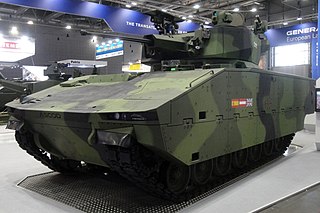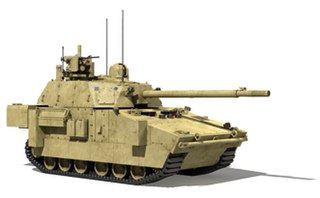 W
WThe ASCOD armoured fighting vehicle family is the product of a cooperation agreement between Austrian Steyr-Daimler-Puch AG and Spanish General Dynamics Santa Bárbara Sistemas. The ASCOD family includes the LT 105, a light tank equipped with a 105 mm gun, a SAM launcher, an anti-tank missile launcher, mortar carrier, R&R vehicle, Command & Control vehicle, ambulance, artillery observer, and the AIFV model. In Spanish service, the vehicle is called "Pizarro", while the Austrian version is called "Ulan".
 W
WKunduz or AZMİM, is a Turkish tracked amphibious combat engineering armoured bulldozer.
 W
WThe Bionix (BX) is a family of tracked Singaporean armoured fighting vehicles developed by Singapore Technologies Kinetics. Intended to augment the Singapore Army's aging M113 armoured personnel carriers, it is the first indigenous armoured vehicle to be developed in Southeast Asia. The Bionix has been operational with the Singapore Armed Forces (SAF) since 1999 in a wide variety of adaptations including the Bionix II, Bionix 25 and Bionix 40/50 variants.
 W
WThe BMPT "Terminator" is an armored fighting vehicle (AFV), designed and manufactured by the Russian company Uralvagonzavod. This vehicle was designed for supporting tanks and other AFVs in urban areas. The BMPT is unofficially named the "Terminator" by the manufacturers. It is heavily armed and armored to survive in urban combat. This AFV is armed with Ataka-T Guided Weapon System armed with four 9M120 Ataka missile launchers, two 30 mm 2A42 autocannons, two AG-17D grenade launchers, and one coaxial 7.62 mm PKTM machine gun.
 W
WThe CM-21 is an armoured vehicle designed and manufactured by the Republic of China Armoured Vehicle Development Center, based on the United States' model M113 APC. The first prototype was manufactured in 1979, and the CM-21 officially entered service in 1982.
 W
WThe Future Combat Systems Manned Ground Vehicles (MGV) was a family of lighter and more transportable ground vehicles developed by BAE Systems Inc and General Dynamics as part of the United States Army's Future Combat Systems (FCS) program. The ground vehicles were to be based on a common tracked vehicle chassis. The MGV program was superseded by the Ground Combat Vehicle which has also been cancelled.
 W
WThe FV434 is the Armoured Repair Vehicle variant of the British Army's FV430 series of armoured fighting vehicles. Introduced in the 1960s primarily as a means of quickly changing Chieftain MBT power packs in the field, it is operated by the Royal Electrical and Mechanical Engineers (REME). It is still used by the REME.
 W
WThe Ajax, formerly known as the Scout SV, is a family of armoured fighting vehicles being developed by General Dynamics UK for the British Army.
 W
WGM is a series of tracked vehicle chassis. Generally, the series is produced by Mytishchi Machine-Building Plant. Some older series were developed and produced by Minsk Tractor Works (MTZ)
 W
WThe Bradley Fighting Vehicle (BFV) is a tracked fighting vehicle platform of the United States manufactured by BAE Systems Land & Armaments, formerly United Defense. It was named after U.S. General Omar Bradley.
 W
WThe M3 Bradley Cavalry Fighting Vehicle (CFV) is an American tracked armored reconnaissance vehicle manufactured by BAE Systems Land and Armaments. A member of the Bradley Fighting Vehicle family, the M3 CFV is used by heavy armored cavalry units in the United States Army.
 W
WThe M132 Armored Flamethrower was a United States built flamethrower armed variant of the M113 and M113A1 armored personnel carriers developed in the early 1960s. Approximately 350 were accepted into service.
 W
WThe M247 Sergeant York DIVAD was a self-propelled anti-aircraft gun (SPAAG), developed by Ford Aerospace in the late 1970s. Based on the M48 Patton tank, it replaced the Patton's turret with a new one that featured twin radar-directed Bofors 40 mm rapid-fire guns. The vehicle was named after Sergeant Alvin York, a famous World War I hero.
 W
WThe Norwegian Model-142 is an anti-tank variant of the American M-113 armoured personnel carrier (APC), the difference being that it is equipped with a TOW2 turret developed in Norway by Kværner Eureka.
 W
WA tank is an armored fighting vehicle intended as a primary offensive weapon in front-line ground combat. Tank designs are a balance of heavy firepower, strong armor, and good battlefield mobility provided by tracks and a powerful engine; usually their main armament is mounted in a turret. They are a mainstay of modern 20th and 21st century ground forces and a key part of combined arms combat.
 W
WThe UR-77 Meteorit is a Soviet mine clearing vehicle, based on a variant of the 2S1 Gvozdika chassis.
 W
WThe Warrior tracked vehicle family is a series of British armoured vehicles, originally developed to replace FV430 series armoured vehicles. The Warrior started life as the MCV-80, "Mechanised Combat Vehicle for the 1980s". One of the requirements of the new vehicle was a top speed able to keep up with the projected new MBT, the MBT-80 – later cancelled and replaced by what became the Challenger 1 – which the then-current FV432 armoured personnel carrier could not. The project was begun in 1972. GKN Defence won the production contract in 1984 and the Warrior was accepted for service with the British Army in November 1984. GKN Defence was purchased by BAE Systems, via Alvis plc.
 W
WThe Type 05 amphibious armored vehicle is a family of amphibious tracked armored fighting vehicles developed by Norinco for the People's Liberation Army Navy Marine Corps, consisting of two main combat variants — the ZBD-05 infantry fighting vehicle and the ZTD-05 assault vehicle, as well as two support variants based on the ZBD-05. The Type 05s could be launched at sea from an amphibious assault ship over the horizon, and features a hydroplane, a design concept that has been compared to the cancelled United States Expeditionary Fighting Vehicle (EFV) program.